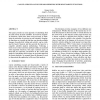Free Online Productivity Tools
i2Speak
i2Symbol
i2OCR
iTex2Img
iWeb2Print
iWeb2Shot
i2Type
iPdf2Split
iPdf2Merge
i2Bopomofo
i2Arabic
i2Style
i2Image
i2PDF
iLatex2Rtf
Sci2ools
WSC
2008
2008
Calculating float in linear schedules with singularity functions
This paper presents an exact approach of calculating float for each activity in linear schedules. It is based on singularity functions, which have been used previously to determine the criticality of activities in said schedules. Singularity functions are versatile in that they can describe multiple changes of productivity within each activity, can be evaluated by hand if desired, and thus provide the basis for a complete schedule analysis methodology. Following a brief review of how activities and their buffers are modeled with singularity functions, this paper examines types of float that are commonly encountered in the critical path method of scheduling and develops an equivalent approach for linear schedules. An example from the literature is used to demonstrate the application of the new float analysis.
Critical Path Method Of Scheduling | Linear Schedules | Modeling And Simulation | Singularity Functions | WSC 2008 |
| Added | 02 Oct 2010 |
| Updated | 02 Oct 2010 |
| Type | Conference |
| Year | 2008 |
| Where | WSC |
| Authors | Gunnar Lucko, Angel A. Pena Orozco |
Comments (0)

